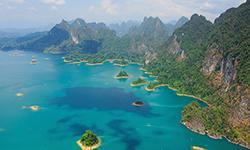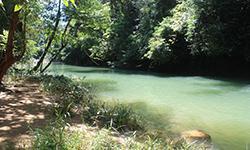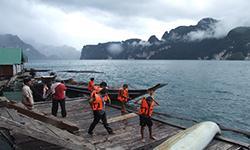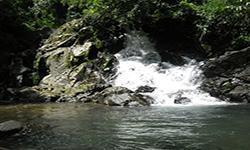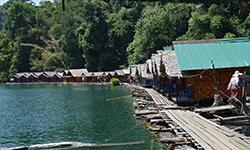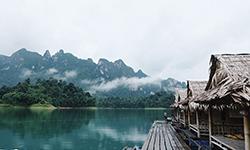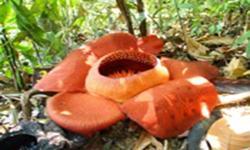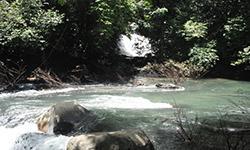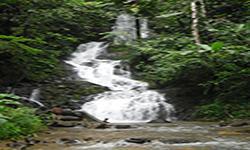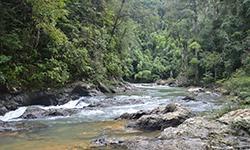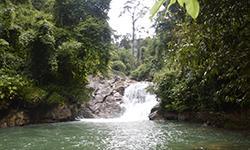Khao Sok National Park
Contact Location : Khao Sok National Park, Moo 6, Khlong Sok Sub-district, Phanom District, Surat Thani Province, 84250
Telephone Number : (+66) 7 739 5139, (+66) 7 739 5155
Email : khaosoknpks@hotmail.com
Facebook : Khao Sok National Park
Information
Khao Sok National Park is the largest and most important tropical rain forest area in the south of Thailand, comprising Khao Sok National Park, Khlong Saeng Wildlife Sanctuary, Khlong Yan Wildlife Sanctuary, Khlong Naka Wildlife Sanctuary, Si Phang-Nga National Park, and Kaeng Krung National Park. It covers an area of 2,296,879.5 rai, or 3,675 square kilometers. It contains high biodiversity, including rare and endemic plants such as ferns, Rafflesia kerri, White Elephant Palm, White Backed Palm and Maxburretia furtadoana. In particular. It is home to four types of preserved wildlife, namely, Muntiacus feac, Serows, Tapir, and Marbled Cats. These, together with the unique natural features of waterfalls, cliffs, caves, and limestone mountains, and the scenery at the Khuean Ratchaprapha Reservoir make it very popular. One of the most famous sites are the 3 limestone karst in the dam and it has been called Guilin of Thailand.
Background
A royal decree specified the area of Khlong Yi Forest and Khlong Phra Saeng is in Khlong Sok , Phangkan and Phanom Sub-district, Phanom District, Phasaeng and Khao Phang Sub-district Ban Ta Khun District Surat Thani Province, covering an area of 645.52 square kilometers or 403,450 rai. It was announced as Thailand’s 22nd National Park in the Royal Gazette Volume 97, Part 197, dated December 22, 1980.
Later, there were changes to the park boundary, which revoked the overlapping area between the Phanom Cooperative Settlement and the Ratchaprapha Dam Reservoir in Khao Sok National Park. The total area was 738.74 square kilometers, or approximately 461,712.5 rai, according to the Royal Gazette Volume 111, Part 32 Ko, dated August 2, 1994.
Note : After paying the entrance fee to the National Park, please carry the receipt for inspection.
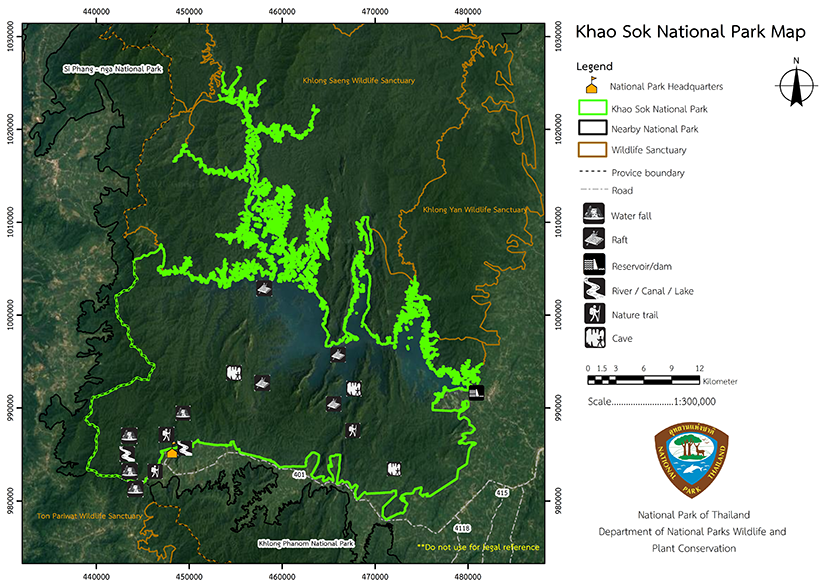
461,712.50 rai (738.74 square kilometers)
|
|
|
|
|
|
|
|
|
|
|
|
|
|
|
|
|
|
|
|
|
|
|
|
Nature trails ⇔ Trekking ⇔ Visit Waterfall ⇔ Cave exploration/Geological condition ⇔ Observe flowers/plant ⇔ Bird , butterfly , wildlife watching activities ⇔ Stargazing ⇔ Take a boat ride or a paddle ⇔ Take a photo/Video ⇔ Camping ⇔ Relax in a natural ⇔ Swimming
Welfare shop : Open for service only during the high season, from 8.30 - 16:30 hrs
National Park Headquarters: AIS, TRUE, DTAC
Ratchaprapha Dam area: DTAC
|
|
The terrain has complex limestone mountains, especially in the Khao Ka Lo Strait, which has several peaks, tower karsts, and earth pillars. There are a few plains with fertile rainforest, which are the water resources of Khlong Sok and Khlong Pha Saeng flowing into Khlong Phum Duang. These are important tributaries for the Tapi river. The highest peak is 961 meters above sea level, and the average elevation is 200 meters above sea level. The soil characteristics are of a reddish sand-clay with laterite traces. To the north of Khao Sok National Park is the Ratchaprapha Dam, which is the embankment of the Khlong Pha Saeng, an area of approximately 168 square kilometers (or 105,000 rai). There are about 165 islets in the area of 14.06 square kilometers. This islets emerge from the water and creates the most beautiful scenery. The geology is of limestone mountains, which are mostly found in the east of the area as part of an 8-kilometer long mountain range. In the west is a clay mountain range, with the Sok Mountain range and Khao Nom Sao. The highest point is 960 meters above sea level. This creates beautiful scenery including features such as waterfalls, caves, and limestone karsts in the 167.29 square kilometers, or approximately 105,000 rai of the Ratchaprapha Dam. Khao Sok National Park is the source of many rivers and canals, with the largest being called Khlong Sok. In the south of the Khao Sok National Park area are Khlong Bang Lan and Khlong Saeng, and to the north are Khlong Yi, Khlong Pae, and Khlong Wang. The Khlong Sok and Khlong Saeng streams merge in Ban Ta Khun District and flow into the Tapi River in the Phanom Cooperative Settlement area. Ratchaprapha Dam to generates electricity for people and businesses in Surat Thani and nearby provinces. Much of the local land is is used as agricultural land, and the local people have rubber plantations and fruit orchards such as rambutan, mangosteen, Lansium parasiticum, and Parkia speciosa. Most of the technology and farmings is manually done, with fertilizers, pesticides, and herbicides used in agriculture and spread by hand. Communities near the National Park Headquarters are engaged in tourism providing accommodation, bungalows, and guided tours in natural areas. The Khao Sok National Park is considered an eco-tourism site and it is of great interest to foreign tourists. The Governor of Surat Thani Province at the time (Mr. Wichit Wichaisan), and other partners, have jointly discussed with Khao Sok National Park that they will create a center for tourism there that linksthe Gulf of Thailand and Andaman in a strategic plan for Surat Thani Province. For Khao Sok National Park take Highway No. 401, the Surat Thani - Takua Pa road, which travels through beautiful scenery with limestone mountains and karsts and many trees providing shade. In 2007, an integrated provincial governor (CEO) was awarded a budget of 25 million baht to construct a multi-purpose pier to serve the tourists at Ratchaprapha Dam, which is also known as or Chiao Lan Dam. Additional areas were annexed at Ban Khao Ya, Khao Phang Sub-district, Ban Ta Khun District, which is an area of ??approximately 4.8 square kilometers. Officials from the Survey Department at the Forest Land Survey Division, the Bureau of Rehabilitation and Conservation Area Development, and the National Parks, Wildlife, and Plant Conservation surveyed the area and found it to be a complete forestof 3,000.94 rai (4.801504 square kilometers), while the invasion area is inappropriate to annex the area of 2,562.31 rai ??(4.099696 square kilometers). |
|
The Khao Sok National Park has a tropical savanna climate, which is under the influence of the monsoon. The southwest monsoon runs from May to September, and brings abundant rainfall. The northeast monsoon blows through in October to December and also brings continuous rain. The dry season begins around the end of December or early January and lasts until April, when the weather is hot, and although drier, it does also rain. This is the best time for tourists to visit the Khao Sok National Park. Weather data collected over 33 years, from1961 to 1995 by the Meteorological Department found that the annual average temperature was 26.4 degrees Celsius, the highest average was 27.9 degrees Celsius in April, and the lowest was 25.0 degrees Celsius in January. The average relative humidity throughout the year is in the range of 8.3%, and the total cumulative rainfall is 1,635.5 millimeters
|
|
|
|
The general forest condition of Khao Sok National Park is that of a moist, evergreen forest, which accounts for 70%of the area and has a dense canopy. The essential plants found are Dipterocarpus gracilis Blume, Mesua ferrea L., Hopea odorata, Barringtonia pendula (Griff.) Limestone forests exist on the mountain ridges and limestone cliffs and are home to drought-tolerant perennials, including herbaceous plants with adhesive root systems, such as Dracaena cochinchinensis (Lour.) S.C. Chen, Dracaena conferta Ridl, Pandanus monotheca Martelli, Atalantia monophylla DC., Hopea ferrea Laness, Burretiodendron esquirolii (H.Lév.) Rehder, Microcos paniculata Linn., and Euphorbia antiquorum L. Rare and endemic plants found in Khao Sok National Park include Rafflesia kerrii, Maxburretia furtado ana, White-Backed Palm, Paphiopedilum exul, Paphiopedilum bellatulum, Cyathea podophylla, and Cassytha filiformis. The Khlong Sok upstream forest is home to plant distributions such as Xylia xylocarpa, Koompassia excelsa, and Neobalanocarpus heimii. Bua Phut (Rafflesia kerrii Meijer), is the largest flower in Thailand, with a diameter of about 70–80 centimeters. It is a parasitic plant that lives on wild grapes of the Tetrastigma papillosum planch, but only the flower is visible. It is a dark red or dark reddish-brown single flower that blooms in the rainy season or when there is high-humidity between May to December. More than 415 species of wildlife live in Khao Sok National Park, including rare species such as the Fea, Serows, Tapir, and Marbled Cat. Other animals include wild elephants, guar, banteng, tigers, leopards, Clouded Leopard, Binturong, raffles, gibbons, and birds such as the Scarlet Forest Birds, Spiny Partridge, Spotted Pigeon, Wild Cuckoos, Green-Billed Malgohas, Big-Necked Kukuls, irKingfisher, Lineated Barbet, Fairy Flycatcher, Common Flameback, Barn Wwallow, Black-Headed Bulbul, Greater Racket-Tailed Drongo, and White-Tailed Munia. There are also amphibians and reptiles such as theSoft Turtle, Flat-Tailed Gecko, Draco maculatus, Spotted Forest Skink, Xenochrophis, Colubrid Snake, Ptyas korros, Mangrove Snake, Common Green Frog, and other types of frog. The Ratchaprapha Dam contains many types of freshwater fish, such as Siamese River Abramine, Chinese Mud Carp, Mystacoleucus marginatus, Harmand's Sole, Henicorhynchus siamensis, Crossocheilus reticulatus, Acantopsis choirorhynchos, Horsefaced Loach, Spotted Loach, Siamese Rock Catfish, Freshwater Garfish, Brachygobius, Blowfish and Dragonfish. |
How to get there by car :
There are two routes to Khao Sok National Park: from Mueang Surat Thani or Takua Pa District, Phang-Nga Province.
Travel along with Highway 401 (Surat Thani - Takua Pa), and turn towards the Khao Sok National Park at the milestone No.109. It is then 1.5 kilometers to the National Park Headquarters.
There are several bus companies that offer bus services from the Southern Bus Terminal to Surat Thani Province. Ask for details at the Southern Bus Terminal Tel. 0-2434-7192, 0-2434-5557-8 or Surat Thani Bus Station on 0-7720-0032-3.
*Note: Khao Sok National Park is most easily reached by private car.
National Park Ranger Station Kho So No. 1 (Khao To Tao)
National Park Ranger Station Kho So No. 2 (Kaeng Chiao Lan)
National Park Ranger Station Kho So No. 3 (Ao Somdet)
National Park Ranger Station Kho So No. 4 (Khlong Pae)
National Park Ranger Station Kho So No. 5 (Khlong Mok)
National Park Ranger Station Kho So No. 6 (Bang Man)
National Park Ranger Station Kho So No. 7 (Krai Son)
Accommodation : Khao Sok 831/8 (Phae Nang Phrai 1)
Khao Sok 832/1-9 (Phae Nang Phrai 2)
Khao Sok 841/1-10 (Phae Ton Toei 1)
Khao Sok 852/1-7 (Phae Krai Son 2)
Khao Sok 865,866,869,870 (Phae Khlong Kha 5,6,9,10)
Khao Sok 871/1-7 (Phae Khlong Kha 11)
Youth camp
Tourist raft
Boys and Girls Youth Camp
There are three groups of accommodation facilities in Khao Sok National Park that are open to visitors:
- At Khao Sok National Park Headquarters
- At Khao Sok National Park Ranger Station Kho So No. 4 (Khlong Pae)
- At Khao Sok National Park Ranger Station Kho So No. 7 (Krai Son)
In addition, in the youth camp area of Khao Sok National Park, there is a conference room with a 60 - 80 person capacity.
There is also a camping ground available, where you can rent tents and equipment. For more information about reservations, contact the Khao Sok National Park or visit the website at http://portal.dnp.go.th/p/nationalpark

